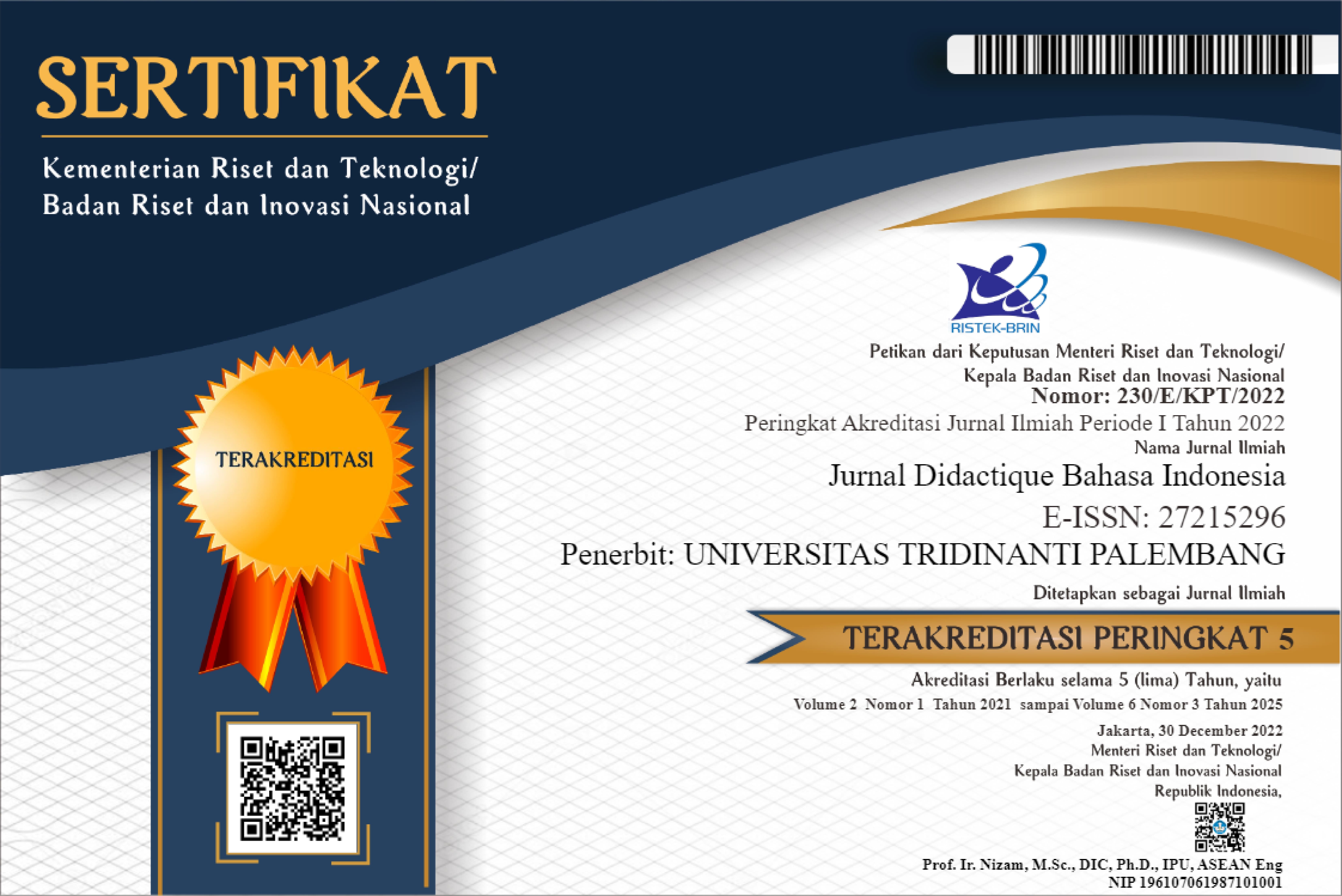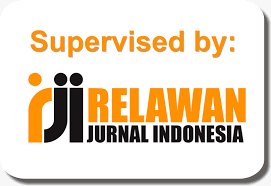TINDAK TUTUR ILOKUSI DALAM DIALOG FILM TARUNG SARUNG KARYA ARCHIE HEKAGERY
Illocutionary Acts in the Dialogue of the Film Tarung Sarung by Archie Hekagery
DOI:
https://doi.org/10.52333/didactique.v5i2.659Keywords:
Tindak tutur, klasifikasi Searle, tarung sarung , budaya MakassarAbstract
ABSTRAK: Penelitian ini berfokus pada tindak tutur ilokusi dalam film Tarung Sarung yang disutradarai oleh Archie Hekagery. Dengan menggunakan pendekatan kualitatif dan metode deskriptif, studi ini mengidentifikasi dan menjelaskan berbagai jenis tindak ilokusi yang ditemukan dalam dialog film tersebut. Pengumpulan data dilakukan dengan teknik observasi dan pencatatan, kemudian dianalisis melalui reduksi data, penyajian data, dan penarikan kesimpulan. Hasil penelitian mengungkapkan bahwa film Tarung Sarung menampilkan 5 jenis tindak tutur ilokusi sesuai dengan klasifikasi Searle: representatif, direktif, ekspresif, komisif, dan deklaratif. Tindak representatif terwujud dalam bentuk pernyataan, pemberitahuan, dan pengakuan. Tindak direktif muncul dalam bentuk perintah, undangan, tantangan, dan nasihat. Tindak ekspresif ditunjukkan melalui ungkapan terima kasih, belasungkawa, permintaan maaf, dan pujian. Tindak komisif terlihat melalui ancaman dan janji. Terakhir, tindak deklaratif digunakan untuk mengubah status atau situasi, seperti keputusan untuk mengakhiri hubungan. Studi ini menyimpulkan bahwa film Tarung Sarung tidak hanya berfungsi sebagai media hiburan tetapi juga sebagai alat komunikasi yang efektif untuk menyampaikan berbagai tindak ilokusi. Selain itu, film ini menyampaikan pesan moral yang kuat, menggabungkan unsur budaya dan agama, serta menekankan pentingnya kearifan lokal dan nilai-nilai budaya Makassar. Penelitian ini memberikan kontribusi signifikan dalam memahami penggunaan tindak ilokusi dalam media film dan konteks komunikasi sehari-hari.
ABSTRACT: This research focuses on illocutionary acts in the film Tarung Sarung, directed by Archie Hekagery. Using a qualitative approach and descriptive method, the study identifies and explains various types of illocutionary acts found in the film's dialogue. Data collection was carried out through observation and note-taking techniques, then analyzed through data reduction, data presentation, and conclusion drawing. The results reveal that the film Tarung Sarung features five types of illocutionary acts according to Searle's classification: representative, directive, expressive, commissive, and declarative. Representative acts are manifested in the form of statements, notifications, and acknowledgments. Directive acts appear in the form of commands, invitations, challenges, and advice. Expressive acts are shown through expressions of gratitude, condolences, apologies, and praise. Commissive acts are evident through threats and promises. Lastly, declarative acts are used to change status or situations, such as decisions to end a relationship. This study concludes that the film "Tarung Sarung" serves not only as a medium of entertainment but also as an effective communication tool for conveying various illocutionary acts. Additionally, the film delivers a strong moral message, combining cultural and religious elements, and emphasizes the importance of local wisdom and Makassar cultural values. This research provides a significant contribution to understanding the use of illocutionary acts in film media and everyday communication contexts.
ABSTRACT: The aim of this research is to test the effectiveness of the online crossword-based PjBL learning model in the explanatory text writing skills of Magelang Regency students. The method used in this research is a one group pretest-posttest experimental method. The population of this study were students in Phase F Science class at Muhammadiyah Mungkid High School. Using questionnaires and tests as data collection techniques. Using quantitative descriptive analysis as a data analysis technique. The results of the research show that the effectiveness of the learning model for writing explanatory text using PjBL based on online crossword learning media is tested effective to use. This is reinforced by the post-test mean score of 88.60 which is greater than the pre-test mean score of 73.20. This shows an increase in students' ability to write explanatory text after using the learning model for writing explanatory text using PjBL based on online crossword media . Apart from that, based on the output the Sig value. (2-tailed) of 0.000. So the Sig value. (2-tailed) 0.000 < 0.05, then H0 is rejected and Ha is accepted. Ha is accepted which means there is a significant difference before and after using the learning model for writing explanatory text using PjBL based on online crossword media . Thus, it can be concluded that the use of this learning model is significantly effective in increasing students' ability to write explanatory texts.
References
Aryani, D. I. P., Kusumawati, Y., Firdaus, Z. A., Septriana, H. & Utomo, A. P. Y. (2022). Tindak Tutur Ilokusi Dalam Film 'Ku Kira Kau Rumah'. PUSTAKA: Jurnal Bahasa Dan Pendidikan, 2(2), 16–32. https://doi.org/10.56910/pustaka.v2i2.136
Asri, R. (2020). Membaca Film Sebagai Sebuah Teks: Analisis Isi Film “Nanti Kita Cerita Tentang Hari Ini (NKCTHI).” Jurnal Al Azhar Indonesia Seri Ilmu Sosial, 1(2), 74. https://doi.org/10.36722/jaiss.v1i2.462
Austin, J. L. (1962). How to do things with words. Oxford University Press.
Permata, E. L., & Nugraha, R. (2022). Tindak Tutur Ilokusi pada Podcast Najwa Shihab dan Maudy Ayunda serta Manfaatnya sebagai Modul Pidato Persuasif. Jurnal Onoma: Pendidikan, Bahasa, Dan Sastra, 8(2), 860–865. https://doi.org/10.30605/onoma.v8i2.2281
Munandar, I., & Darmayanti, N. (2020). Tindak Tutur Ilokusi dalam Pidato Ridwan Kamil pada Acara Bukatalks: Suatu Kajian Pragmatik. Jurnal Metabasa, 3(1), 25–40.
Purba, A. (2011). Tindak Tutur dan Peristiwa Tutur. Pena: Jurnal Pendidikan Bahasa Dan Sastra, 1(1), 77–91. https://online-journal.unja.ac.id/pena/article/view/1426
Sagita, V. R. (2019). Tindak Tutur Ilokusi Ridwan Kamil dalam Talkshow Insight di CNN Indonesia. Lensa: Kajian Kebahasaan, Kesusastraan, Dan Budaya, 9(2).
Sari, N. D., Auzar, & Sinaga, M. (2022). Tindak Tutur Ilokusi dalam Dialog Film Kisah untuk Geri Karya Monty Tiwa. Jurnal Pendidikan Tambusai, 6(1), 1990–1997. https://www.jptam.org/index.php/jptam/article/view/3245%0Ahttps://www.jptam.org/index.php/jptam/article/download/3245/2708
Searle, J. (1979). Expression and meaning: Studies in the theory of speech acts. Cambridge University Press.
Nadiroh, S., Rini, P. S., Pratiwi, D. E., & Istianah, I. (2022). Tindak Tutur Ilokusi pada Film Tak Kemal Maka Tak Sayang Karya Fajar Bustomi. Prosiding Seminar Nasional Pendidikan, Bahasa, Sastra, Seni, Dan Budaya, 1(1), 192–208. https://doi.org/10.55606/mateandrau.v1i1.176
Urbaningrum, T., Triana, L., & Sari, V. I. (2022). Tindak Tutur Ilokusi Pada Youtube Nihongo Mantappu “Jika Aku Menjadi Menteri Pendidikan….” Jurnal Ilmiah SEMANTIKA, 3(02), 91–100. https://doi.org/10.46772/semantika.v3i02.593
Oktiawalia, Z. Rahmita, Ariesya, R. O., Husnul Khotimah, A. M., Setiawan, K. E. P., & Utomo, A. P. Y. (2022). Analisis Tindak Tutur Ilokusi dalam Film Mariposa Karya Alim Sudio. CENDEKIA: Jurnal Ilmu Sosial, Bahasa Dan Pendidikan, 2(2), 56–73. https://doi.org/10.55606/cendikia.v2i2.298
Downloads
Published
How to Cite
Issue
Section
License
Copyright (c) 2024 Nur Irmayanti Umar -; Arief fiddienika

This work is licensed under a Creative Commons Attribution-NonCommercial-ShareAlike 4.0 International License.








